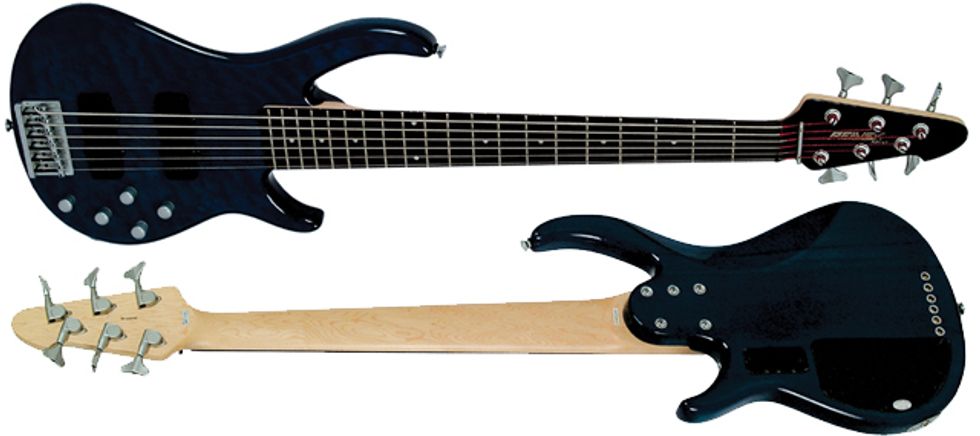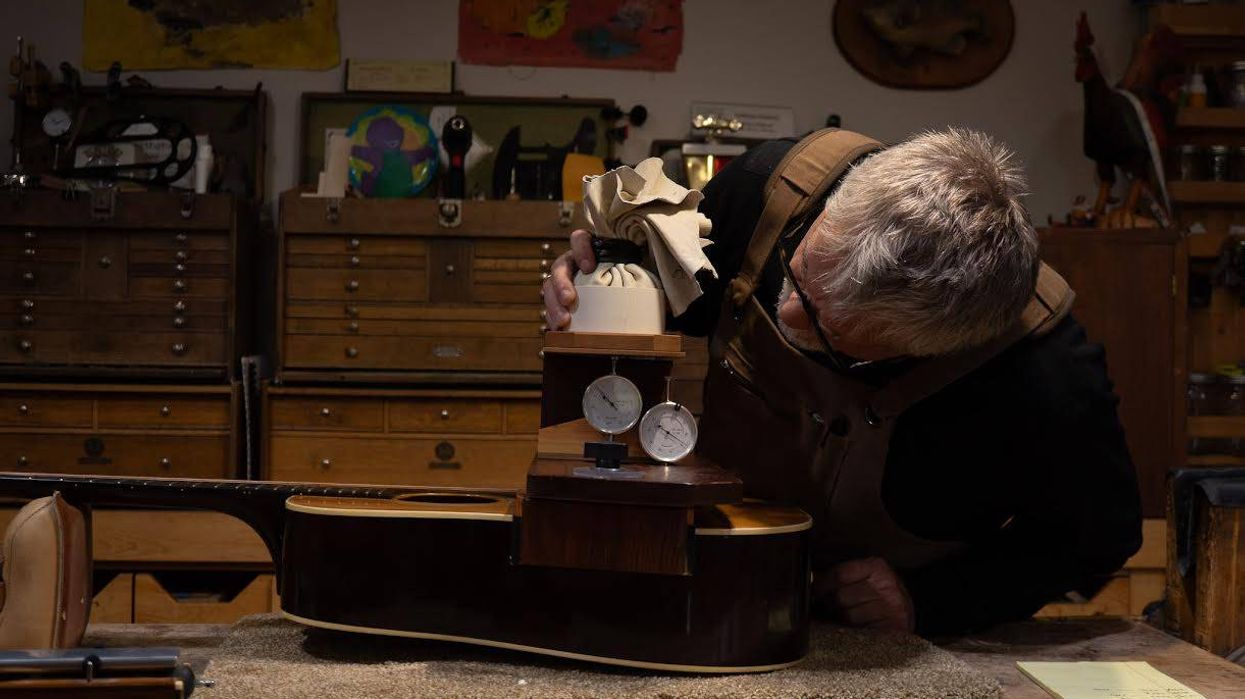Top: Discontinued in 2003 and currently valued between $300 and $350, this Fury 6 model
6-stringer features a pair of active VFL pickups and a 3-band EQ.
Bottom: This Fury 6 sports a transparent blue finish, but the model was also offered in transparent
red, transparent green, and sunburst, and was available in 4- and 5-string versions.
Hey Zach,
This Fury is my go-to bass! I love it
and I’m interested in the history of
Fury basses, but there appears to be
some different variations. Can you
give me any background about them
and maybe some information about
what they are worth today? I’d never
sell mine, but I’m interested in buying
another one for a backup.
Thanks!
Bryan in Fort Wayne, Indiana
Hi Bryan,
I’m glad you asked about a Peavey because
Hartley Peavey (founder and president
of Peavey) is a good friend of mine and
I have a lot of respect for what he has
brought to the music industry. Hartley is
a true innovator when it comes to guitars,
amplifiers, and other electronics, and your
Fury bass is just one example of his many
contributions. But what people may not
realize is that several of his ideas have
been followed by others.
Hartley Peavey was born and raised in Meridian, Mississippi (where the company is headquartered and he still resides today), and worked in his father’s music store growing up. Peavey then began building guitar amplifiers by hand and developed a reputation locally for his talents while playing in various bands in college. When it appeared a music career wasn’t an option, he decided to go into business building electronics. And in 1965, he started Peavey Electronics in the attic of his father’s music store. Peavey initially focused on PA systems and components before moving into guitar amplifiers by the late 1960s.
In 1975, Peavey decided to get into the guitar business. By the mid-1970s, many of the large guitar manufacturers were producing lower-quality instruments, yet at the same time, they were costing more. This stemmed from paying skilled craftsmen large salaries to build instruments, and because of corporate involvement, rushing production in an effort to reduce costs. Peavey saw this problem in the industry and came up with the idea to produce guitar necks using a computer and copy lathe. Not only did this speed up the production time, but it also ensured that every neck would be the same and fit flawlessly with other components. And as we know, this is a process now used by nearly every major guitar manufacturer!
The first Peavey guitars rolled off the production line in 1977 with the T-60 guitar and the T-40 bass. Several other variations of the “T” series were released in 1981 and 1982, but in 1983, Peavey introduced a plethora of new guitar and bass lines. And one of them was the Fury bass. The original Fury was quite similar to a Fender Precision—with a slightly different body shape and Peavey’s original headstock design—and remained part of Peavey’s product offerings until 1998.
In 1999, the Fury II bass was released, but it featured an entirely different body shape than its predecessor. In 2001, Peavey introduced a higher-end Fury bass with a quilted-maple top. Peavey offered Fury basses in 4-, 5-, and 6-string configurations, and you have the latter—the Fury 6.
Fury basses featured a sculpted lightweight body (made of unspecified wood) with a quilted-maple top, bolt-on maple neck, 20-fret rosewood fretboard, two VFL (vertical flux loading) active pickups, and a 3-band active equalizer. Along with the transparent blue your bass is finished in, the model also came in transparent red, transparent green, and sunburst.
When your model was discontinued in 2003, the MSRP (manufacturer’s suggested retail price) was $700. Today, your Fury 6 is worth between $300 and $350 in excellent condition. This might seem low, but the thing about Peavey guitars and basses is that they produced a lot of them (production totals were 300 per day during the late 1970s) and the price points have always been traditionally affordable, which translates to their used values today. Peavey started building instruments to offer quality and affordability— something his competitors were unable to do at the time.
Most Peavey instruments are built overseas these days, but Peavey still uses the same methodology and production techniques to keep costs down while building a quality instrument at the same time. In my opinion, Peavey has seen so much success because he was able to see what the major manufacturers weren’t doing and capitalized on it. I hope you can find another Fury bass treasure to add to your arsenal!
 Zachary R. Fjestad
is author of Blue Book of
Acoustic Guitars, Blue Book
of Electric Guitars, and Blue
Book of Guitar Amplifiers.
For more information, visit
bluebookinc.com or email
Zach at guitars@bluebookinc.com.
Zachary R. Fjestad
is author of Blue Book of
Acoustic Guitars, Blue Book
of Electric Guitars, and Blue
Book of Guitar Amplifiers.
For more information, visit
bluebookinc.com or email
Zach at guitars@bluebookinc.com.






![Rig Rundown: AFI [2025]](https://www.premierguitar.com/media-library/youtube.jpg?id=62064741&width=1245&height=700&quality=70&coordinates=0%2C0%2C0%2C0)












 Shop Scott's Rig
Shop Scott's Rig















































